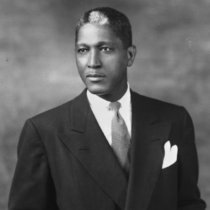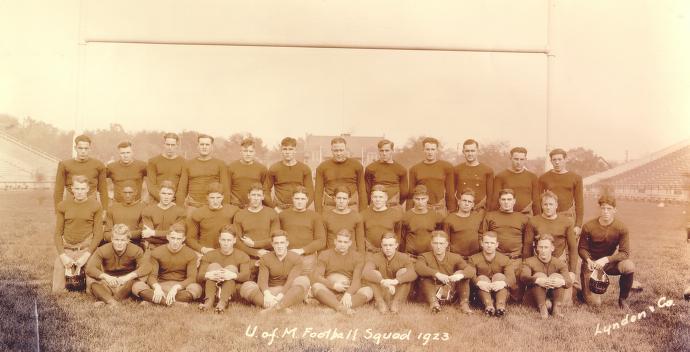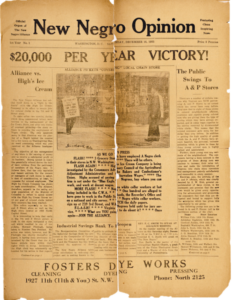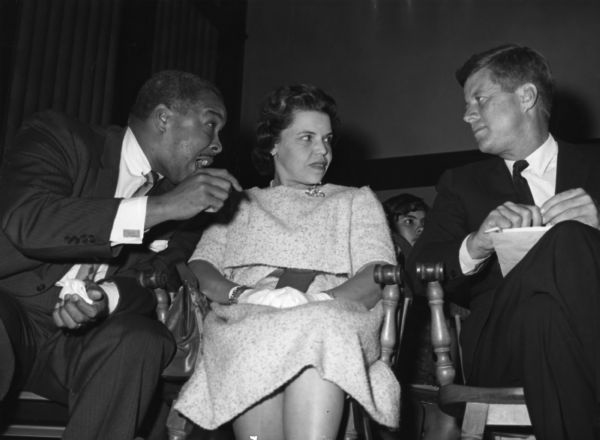Magazine

The Business of the Hour
Belford Lawson’s work as a lawyer and activist changed the course of civil rights in the United States. He was the first Black lawyer to win a case in front of the U.S. Supreme Court, and he used his U-M fraternity connections to help with a second, landmark ruling. His incredible story is told, in part, through archived materials at the Bentley.
By Greg Kinney
In the summer of 1933, in the depths of the Great Depression, writer and activist John Aubrey Davis was outraged when the Hamburger Grill on “U” Street in Washington, D.C., fired three Black employees and gave the jobs to whites. Davis and some friends organized a picket line demanding the Black employees be rehired, especially since the grill served a predominantly Black clientele. The Black workers were quickly rehired with higher pay and better hours.
Armed with that success, Davis, along with newly minted attorney Belford Lawson, and recent college graduate M. Franklin Thorne, formed the New Negro Alliance (NNA) to pressure other white-owned businesses that served predominantly Black clientele to hire a proportional number of Black workers. The NNA would employ picketing, street protest, and economic boycotts to pressure businesses. Lawson was the NNA’s lead attorney.
When a grocery chain took legal action to stop the NNA’s picketing, Lawson fought the case all the way to the U.S. Supreme Court—winning a landmark ruling that would be vital to the Civil Rights Movement. He would be the first African American attorney to successfully argue a case before the nation’s highest court.
Papers at the Bentley show that, long before he argued in front of the Supreme Court, Belford Lawson made a name for himself at U-M as an athlete, orator, and fraternity member. Further research in court records, newspaper stories, and secondary sources reveals that his victories would go far beyond campus—he would become a significant civil rights lawyer, a noted public speaker, national president of Alpha Phi Alpha fraternity, a close advisor to Senator and presidential candidate John F. Kennedy, and president of the YMCA.
More Than Manual Labor
Belford Vance Lawson Jr. was born July 9, 1904, in Roanoke, Virginia, the seventh of 11 children of Belford Sr. and Sarah Lawson. Belford Sr. worked in the Norfolk Southern railroad yard in Roanoke. Belford Jr. grew up and attended elementary school in Roanoke’s Gainsboro neighborhood, but the city did not provide a high school for African Americans at that time. Lawson enrolled at historically Black Hampton Institute in 1916.
Hampton at the time was mainly a manual arts training school, and Lawson’s program was focused on carpentry. Lawson’s son later recalled the story that “while atop a Hampton building hammering nails, he concluded he was not intellectually challenged. He threw the hammer to the ground and descended the ladder. He aspired to more than manual labor.”
After completing the spring 1918 term, Lawson followed the well-established, if somewhat improbable, path of several dozen Hampton students to Ferris Institute in Big Rapids, Michigan. Described as something more than a high school but not quite a college, Ferris was known for its open enrollment policy without regard to gender, race, or academic background.
Lawson spent one year at Ferris in the college prep program. He played on the varsity football and baseball teams and was a member of the campus ROTC. The 1919 football team was not very successful, but one newspaper reported that Lawson “drew the admiration of the crowd by his pluck.” Lawson enrolled in the University of Michigan College of LSA in the fall of 1920.
He decided to try to continue his football career—despite the well-known antipathy of coach Fielding Yost toward Black players. In Yost’s 20-year tenure at Michigan, not one Black player had made the varsity squad. Three Black players are known to have tried out for the team, but none made the varsity roster. Lawson and one other Black student were on the freshman team in 1920, but neither was awarded a letter. Lawson won “R” letters with the reserve team in 1921 and 1922. He was on the varsity squad, at least briefly, in 1923. He is listed in some game programs and is in a full-squad photo, but never played in a varsity game.

Belford Lawson is in the middle row, second from the left. BL006492
Football was only a part of Lawson’s life on campus. He was an excellent student, an active member of Alpha Phi Alpha fraternity, and a prize-winning orator.
Lawson made it to the finals for the Atkinson oratory prize—established by the family of alumnus Charles Maurice Atkinson, who died in 1922—where each of the six contestants spoke on the topic of “Student Character, Moral and Spiritual for World Citizenship.”
Lawson’s winning speech began by acknowledging the influence of the university and those who labored there, but he said for students, “the business of the hour calls on us to do our own thinking.” Lawson received $50 and a gold medal. He received some attention in the national press, which often noted that a Black student had won the first Atkinson prize. The Bloomington-Normal Pantagraph headlined its story “Negro Halfback Wins Oratorical Honors.”
Seven months later, Lawson and his fellow Atkinson competitor Lyman Glasgow received some publicity of a different sort (see sidebar below). Lawson received his B.A. in June 1924 and took a job at Jackson College (now Jackson State University) as instructor of social science and director of the Teachers’ Professional Department. He was also football coach and athletic director. He stayed at Jackson College for three years before moving briefly to Morris Brown College in Atlanta. There, his interest in law school was revived.
Lawson was admitted to Yale Law School, where he studied for two years before financial difficulty forced him to leave. He settled in Washington, D.C., where he worked for the Supreme Liberty Life Insurance Company and enrolled in Howard University Law School. He studied under Charles Houston, the legendary mentor of a remarkable group of law students and attorneys in the early 1930s who would go on to litigate many of the most important cases in the effort to dismantle Jim Crow. Lawson received his LL.B. in 1932 and opened a practice in Washington, D.C., in 1933 with Theodore Berry, a Cincinnati attorney and fraternity brother.
The Hamburger Grill protests, and the subsequent formation of the NNA, formed the early basis for Lawson’s career and provided a glimpse of his future work as a lawyer and civil rights activist.
“Don’t Shop Where You Can’t Work”
After the Hamburger Grill success, Davis and Lawson convened a group of D.C. activists and community leaders to expand NNA activities. “Don’t shop where you can’t work” became their organizing slogan.
The NNA conducted surveys to measure the ratio of a business’s Black customers to Black employees and then targeted the worst offenders. It published a newspaper to build community support. The NNA had considerable success in expanding job opportunities for D.C.’s Black residents, and the organization soon appeared in other cities.

Lawson helped publish the New Negro Opinion paper from 1933–1937, which protested discriminatory employment practices in the Washington, D.C., area and offered strategies to fight injustices. Image courtesy of the Anacostia Community Museum Archives, Smithsonian Institution.
However, some businesses fought back. The NNA’s picketing of the Sanitary Grocery store in Washington, D.C., became the crucial case, and a 1936 dispute would make its way to the U.S. Supreme Court.
Sanitary Grocery Company (later to become Safeway) obtained an injunction against the NNA. The injunction was upheld by a judge who ruled this was not a labor dispute as defined by the 1932 NorrisLaGuardia Act, which established labor unions’ right to picket in labor disputes, but “only a protest by Negroes, to obtain jobs for Negroes.” The ruling was affirmed by the U.S. District Court.
Lawson appealed to the U.S. Supreme Court, arguing the NNA represented a class of citizens affected by Sanitary’s discriminatory employment policy and that Norris-LaGuardia’s protection extended beyond labor unions. The high court decisively overturned the lower court’s ruling. As Davis later remarked, the case established “the right to picket by non-labor union people. This case is one on which everybody else has been able to build.”
Lawson was honored at a banquet in New York City and celebrated for his success—at least in the African American press. A New York Age story described him as “the attorney whose legal brilliance starred in the victory of the New Negro Alliance case.”
But it would just be the start.
Dining Car Curtains
In the Southern Railway Company’s dining cars, the two tables nearest the kitchen (the least desirable) were set aside for Black passengers with a curtain separating the Black and white tables. However, if the white section was full, the curtain could be drawn and white passengers could use the Black tables, forcing Black passengers to wait.
Elmer Henderson, an inspector for the Federal Fair Employment Practices Commission, was traveling from Washington, D.C., to Atlanta on business in 1942. Because the dining car was continually filled by white passengers, Henderson never got his meal. He filed a complaint with the Interstate Commerce Commission (ICC).
In a ruling two years later, the ICC acknowledged Henderson had been unfairly treated and that the railroad’s dining car policy was discriminatory but found no basis for an award of damages. The Southern Railway’s remedy was to reserve the two tables exclusively for Black passengers, even if the white section was full.
Henderson was not satisfied and decided to sue. It was here that Lawson entered the case. For nearly six years he would lead a team of attorneys guiding Henderson’s cause to the U.S. Supreme Court.
The court announced its decision in Henderson outlawing segregation in railroad dining cars on June 5, 1950. It was a major victory in the cause of civil rights, but the ruling was narrowly based on ICC regulation rather than the constitutional basis for the “separate but equal” doctrine of Plessy v. Ferguson. Henderson and two other cases announced that day, though, did put a chink in Plessy’s armor.
Speak for the Dawn
In the Henderson case, Lawson reached out to his Alpha Phi Alpha (APA) brothers for statements about their experience of mistreatment on segregated U.S. railroads to help convey to the court “the brutalizing and humiliating effects of this type of public humiliation.” Lawson was an Alpha Phi Alpha man to his core, but not an uncritical one.
He had joined APA’s Epsilon chapter as a sophomore at Michigan and would be involved in its affairs for his entire life, using the networks and friendships it provided in support of variety of causes.
He served as APA’s general counsel and was elected general president in 1946. One of his goals was to move the fraternity beyond its traditional social and philanthropic activities to a more direct involvement in current political and social movements. He issued a stirring call at the 1947 convention:
The great decision of this generation of Alpha men is whether we shall, with every ounce of our energy, with every dollar of our treasury, with every fiber of our mind and soul, deny the gigantic conspiracy to preserve our segregated status quo, and destroy the mighty, monstrous mockery of human decency and dignity, the yoke of Jim Crow which hangs around our necks. To compromise is to evade the crucial. I call to action! Let us speak for the dawn.
His presidency of the fraternity was just one of his many leadership roles. While growing up in Roanoke, Lawson had been barred from using the whitesonly YMCA facilities. In a 1938 speech to a meeting sponsored by the Harlem Labor Union, Lawson included the YMCA among white-dominated organizations that African Americans should not place their faith in. Many years later, though, he became active in the Washington, D.C., YMCA and served as chairman of its Board of Directors.
The national YMCA formally abolished racial discrimination in all of its branches in 1967. Lawson was elected national chairman of the YMCA in 1973.
The Lawsons and the Kennedys
Lawson met his match in Marjorie Alice McKenzie, a Pittsburgh native, who earned her undergraduate degree and a certificate of social work from U-M in the 1930s. She moved to Washington, D.C., for work and began taking night courses at the historically Black Robert H. Terrell Law School, where Lawson was a volunteer instructor.
Marjorie received her Terrell degree in spring 1939, and she and Lawson wed later that year at Riverside Church in New York, possibly the first African American couple to marry in the historic church. Marjorie joined the Lawson and Berry firm and participated in some of Belford’s civil rights cases. Her own practice focused primarily on real estate law and public housing issues. From 1941–1955, she wrote a weekly public affairs column for the Pittsburgh Courier.
In the late 1940s, a white, Ivy League-educated lawyer got a job Marjorie had hoped for, on the implication that Marjorie’s Terrell degree was not up to par. This prompted Marjorie to earn a J.D. from Columbia in 1950, because “she never wanted her legal credentials challenged again.”
The Lawsons’ home on Logan Circle was a salon of sorts for Washington, D.C.’s Black civil rights and political activists, frequently hosting meetings and receptions. The house would later be designated a historic site on the district’s Civil Rights Tour.

Marjorie Lawson (middle) was appointed to the D.C. Juvenile Court by President John F. Kennedy (right) in 1962. Image courtesy of the Wisconsin Historical Society.
Both Lawsons became actively involved in the senate and presidential campaigns of John F. Kennedy. Belford Lawson first crossed paths with U.S. Rep. Kennedy at the 1952 Democratic Convention. Four years later, that casual acquaintance developed into a genuine friendship and collaboration. Lawson was a delegate from Washington, D.C., at the 1956 convention—as well as the first African American to address the Democratic Party National Convention. He supported Kennedy’s bid for the vice-presidential nomination, even though the D.C. delegation was committed to Estes Kefauver. Kennedy’s bid failed, but he later asked for Lawson’s aid in his 1958 Senate reelection campaign.
Lawson did not want to leave his law practice at the time, but he recommended someone else to Kennedy: his wife. Marjorie would go on to work on Kennedy’s 1958 Senate campaign staff and was named director of his presidential campaign’s civil rights section, in which she was Kennedy’s primary liaison to Black political, religious, and women’s organizations. She did advance work and often traveled with the candidate. She was appointed to the D.C. Juvenile Court by President Kennedy in 1962, and President Johnson in 1965 named her the U.S. representative to the United Nations Economic and Social Council.
Belford Lawson became an informal advisor to Kennedy’s 1960 presidential campaign. He introduced Kennedy to many leaders in the African American community, in particular to editors and publishers from the Black press, and helped them overcome their initial skepticism toward Kennedy.
A Brilliant Shining Ray
Belford Lawson practiced law until retiring in 1977. He died February 23, 1985.
It is apt that his legacy lives on through APA’s Belford V. Lawson Oratory Competition, established in 1985. It is a tribute to his eloquence and the many speeches he delivered to APA chapters and civic groups across the country.
Lawson was memorialized with several pages of tributes in APA’s national magazine, The Sphinx. One fraternity brother recalled Lawson’s speech as APA president in 1946 as “a brilliant, shining ray to a new generation… saying to the world in a loud, stentorian voice, ‘Yes, Alpha Phi Alpha and Black America, we have a future, to be coupled with our glorious past.’”
[Lead image: Belford Lawson portrait, Courtesy of Archives Center, National Museum of American History]
Letters from the Klu Klux Klan
The front page of The Michigan Daily on January 17, 1924, carried a story with the headline: “‘Leave Town,’ Says Alleged Letter of Klan.”
The letter was dropped into the mailbox of Lyman Glasgow, who was white, a cheerleader, and member of the debate team. The unposted letter, written on “bluebook” paper, advised Glasgow, “Leave Ann Arbor now as a result of unfriendly things you have said concerning the K.K.K.”
The letter referred to Glasgow’s recent oration in a public speaking class, which had been critical of the Klan. According to the article, Glasgow assumed the letter was written by “some newly elected student Klansman.” Glasgow had no plans to leave town.
Belford Lawson had also received a letter, signed “K.K.K.,” just a few weeks before, in December 1923. Lawson wasn’t advised to leave town, but was told he was “too active,” he should “stay in his place” and “speak when spoken to.”
Initially, Lawson brushed the letter off as simply “someone who didn’t like me.” Lawson said the letter “didn’t frighten me any.”
The article closed by noting the “Invisible Empire” had burned its first cross in Ann Arbor the previous Saturday night. By the summer of 1924, when Lawson graduated from U-M, K.K.K. rallies surged across the state, with thousands gathering in Jackson, Lansing, and Ann Arbor.
